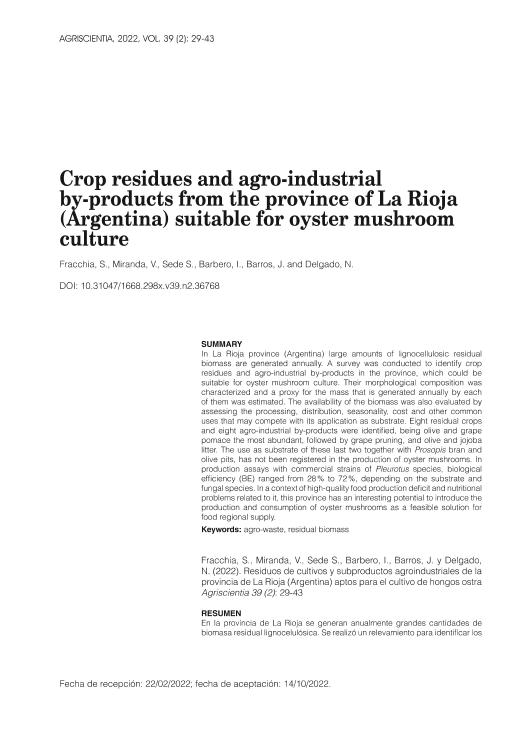Artículo
Crop residues and agro-industrial by-products from the province of La Rioja (Argentina) suitable for oyster mushroom culture
Fecha de publicación:
10/2022
Editorial:
Universidad Nacional de Cordoba. Facultad de Ciencias Agropecuarias
Revista:
AgriScientia
ISSN:
0327-6244
e-ISSN:
1668-298X
Idioma:
Inglés
Tipo de recurso:
Artículo publicado
Clasificación temática:
Resumen
In La Rioja province (Argentina) large amounts of lignocellulosic residual biomass are generated annually. A survey was conducted to identify crop residues and agro-industrial by-products in the province, which could be suitable for oyster mushroom culture. Their morphological composition was characterized and a proxy for the mass that is generated annually by each of them was estimated. The availability of the biomass was also evaluated by assessing the processing, distribution, seasonality, cost and other common uses that may compete with its application as substrate. Eight residual crops and eight agro-industrial by-products were identified, being olive and grape pomace the most abundant, followed by grape pruning, and olive and jojoba litter. The use as substrate of these last two together with Prosopis bran and olive pits, has not been registered in the production of oyster mushrooms. In production assays with commercial strains of Pleurotus species, biological efficiency (BE) ranged from 28 % to 72 %, depending on the substrate and fungal species. In a context of high-quality food production deficit and nutritional problems related to it, this province has an interesting potential to introduce the production and consumption of oyster mushrooms as a feasible solution for food regional supply.
Palabras clave:
AGRO-WASTE
,
RESIDUAL BIOMASS
Archivos asociados
Licencia
Identificadores
Colecciones
Articulos(IBODA)
Articulos de INST.DE BOTANICA DARWINION (I)
Articulos de INST.DE BOTANICA DARWINION (I)
Citación
Fracchia, S.; Miranda, V.; Sede, Silvana Mabel; Barbero, I.; Barros, J.; et al.; Crop residues and agro-industrial by-products from the province of La Rioja (Argentina) suitable for oyster mushroom culture; Universidad Nacional de Cordoba. Facultad de Ciencias Agropecuarias; AgriScientia; 39; 2; 10-2022; 29-43
Compartir
Altmétricas




